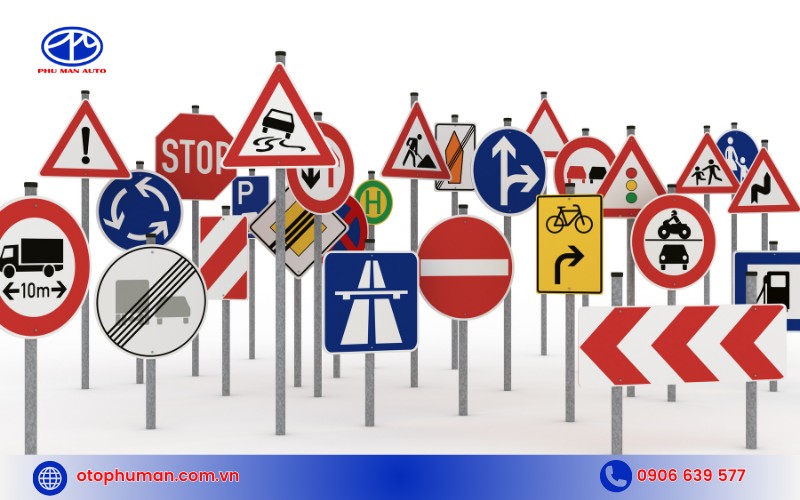Navigating challenging roads requires not only skilled heavy truck driving but also a deep understanding of the transportation industry. Xe Tải Mỹ Đình, as a truck expert, shares 10 heavy truck driving tips to help drivers conquer every journey and achieve success in their careers.
Take Time to Understand Your Heavy Truck
Before embarking on a heavy truck driving journey, the first and most crucial step is to familiarize yourself with your truck. A thorough understanding of its technical specifications, structure, and operating principles is the foundation for confidence and safety on any road. Study the braking system, suspension system, transmission system, how to operate the gearbox, and other driving assistance systems. Mastering this knowledge will help you make informed decisions and handle emergencies effectively.
Learning to drive a heavy truck is a process that requires patience and regular practice. Don’t hesitate to spend time practicing your driving skills, from basic operations such as starting, stopping, and shifting gears, to more complex skills such as U-turns, reversing, parking, and handling unexpected situations on the road. Mastery of vehicle control will bring safety and comfort to you throughout the journey.
 Close-up of a driver inspecting the engine of a heavy truck
Close-up of a driver inspecting the engine of a heavy truck
Master the Road Traffic Sign System
Knowledge of the road traffic sign system is a key factor in the experience of driving a heavy truck. Traffic signs are not just symbols on the road, but also an important communication language between drivers and the road system. Mastering the meaning and complying with the orders of traffic signs helps you proactively control your speed, orient your movement, and predict traffic situations that may occur.
For heavy truck drivers, understanding the types of prohibition signs, warning signs, instruction signs, and especially the signs related to vehicle load and dimensions is extremely important. Strict adherence to these signs not only ensures safety for yourself and others but also avoids unnecessary traffic violations.
 A collage of various road traffic signs
A collage of various road traffic signs
Some important types of signs that heavy truck drivers need to pay special attention to:
- Prohibition signs: Recognize and comply with signs prohibiting stopping, parking, left turns, right turns, overtaking, going against the traffic, and other prohibition signs.
- Speed limit signs: Always pay attention to the maximum speed limit signs and maintain appropriate speed, especially on densely populated roads, bad roads, or roads with complex terrain.
- Instruction signs: Use directional signs to orient your route, determine the distance to locations, and choose the appropriate direction, especially when traveling on unfamiliar routes.
- Vehicle load and size restriction signs: Absolutely comply with signs limiting axle load, total vehicle weight, height, width, and length allowed. Violating these regulations can lead to the risk of accidents, damage to roads, and severe penalties.
Always Prioritize the Principle of Giving Way
The principle of giving way is one of the most important heavy truck driving experiences, demonstrating civilized traffic culture and the responsibility of the driver. Giving way is not only an act of complying with traffic laws, but also a respect and sharing of travel space with other road users.
When driving a heavy truck, you need to pay special attention to giving way in the following situations:
 A heavy truck yielding to pedestrians at a crosswalk
A heavy truck yielding to pedestrians at a crosswalk
- At intersections (three-way, four-way):
- When there is a “Give Way” sign, slow down, observe carefully and give way to priority vehicles, vehicles on the main road, and vehicles coming from the right.
- At intersections without signs, give way to vehicles coming from the right according to the principle “the right is clear”.
- Always give way to pedestrians and bicycles, especially in densely populated areas and areas with pedestrian crossings.
- When entering a priority lane:
- When moving from a side road to a main road, slow down, observe carefully and give way to vehicles traveling on the main road.
- Do not cut in, overtake recklessly, or tailgate other vehicles to enter the lane, causing danger to yourself and other vehicles.
- Other situations of giving way:
- Give way to priority vehicles (fire trucks, ambulances, police, military) when there are siren signals and priority lights.
- Give way to vehicles that have entered the roundabout before you want to enter the roundabout.
- Give way to smaller vehicles when moving through narrow or obstructed areas.
- Give way to pedestrians, people with disabilities, and the elderly.
Focus Highly on Observing Rearview Mirrors
Rearview mirrors are the “second eyes” of a heavy truck driver. Regularly observing the rearview mirrors helps you grasp the traffic situation behind and on both sides of the vehicle, detect potential risks early, and react promptly. Effective rearview mirror observation skills are a key factor in ensuring safety when driving, especially with heavy trucks that are large and have many blind spots.
 Driver constantly checking rearview mirror
Driver constantly checking rearview mirror
To observe rearview mirrors effectively, heavy truck drivers need to note:
- Adjust rearview mirrors appropriately: Before starting, adjust the rearview mirrors so that you can observe the entire space behind and on both sides of the vehicle, minimizing blind spots.
- Observe regularly and continuously: Develop the habit of observing rearview mirrors at least every 5-10 seconds, and increase the frequency of observation when moving in crowded areas, when changing lanes, turning, or when there is a warning signal from other vehicles.
- Observe all three rearview mirrors: Do not only focus on the center mirror, but also observe the left and right mirrors regularly to have a comprehensive view of the traffic situation around the vehicle.
- Pay attention to blind spots: Be aware of the blind spots of heavy trucks and increase direct observation by quickly turning your head to check the blind spot before changing lanes or turning.
Speed Control – The Key to Safety on Every Journey
Speed control is a factor that determines safety when driving a heavy truck. With large weight and high inertia, heavy trucks need a much greater braking distance than cars. Maintaining a speed appropriate to road conditions, weather, and traffic density helps you proactively control the vehicle, avoid sudden braking situations, and minimize the risk of accidents.
 Speedometer showing a moderate speed in a heavy truck
Speedometer showing a moderate speed in a heavy truck
To control speed effectively when driving a heavy truck, you need to:
- Comply with speed limits: Always strictly comply with the speed limits prescribed for each type of road and each area.
- Slow down when necessary: Proactively slow down when entering curves, when moving on bad roads, slippery roads, mountain passes, or when visibility is limited due to bad weather (rain, fog, dust).
- Maintain a stable speed: Avoid sudden acceleration and deceleration, especially when carrying fragile goods or when traveling on highways.
- Use engine brake: Take advantage of the engine brake to slow down the vehicle smoothly and effectively, especially when going downhill or when needing to slow down from high speed. Limit the continuous use of foot brakes, which causes brake overheating and reduces braking efficiency.
Maintain a Safe Distance – A Protective “Buffer Zone”
Maintaining a safe distance from the vehicle in front is a golden rule when driving a heavy truck. The safe distance acts as a “buffer zone” that gives you enough time and space to handle unexpected situations, avoid collisions, and ensure safety for yourself and other vehicles. With heavy trucks, the safe distance needs to be maintained wider than with cars due to their large size and weight.
 Diagram illustrating safe following distance between vehicles
Diagram illustrating safe following distance between vehicles
To maintain a safe distance effectively when driving a heavy truck, you can apply the following principles:
- The 3-second rule: Choose a fixed point on the road (sign, utility pole, lane marker). When the vehicle in front passes that point, start counting “one thousand one, one thousand one hundred two, one thousand one hundred three”. If your vehicle reaches that point before counting “one thousand one hundred three”, you are driving too close and need to increase the distance.
- Adjust according to conditions: Increase the safe distance when weather conditions are bad (rain, fog, strong wind), when visibility is limited, when traveling at night, or when traveling on bad roads or slippery roads.
- Observe and adjust continuously: Regularly observe the distance from the vehicle in front and adjust the speed to maintain an appropriate safe distance. Avoid tailgating other vehicles, especially container trucks or vehicles carrying construction materials.
Reversing, Turning Heavy Trucks – A Skill to Practice
Reversing and turning are difficult skills that require precision and caution when driving a heavy truck. The large size and limited visibility of heavy trucks make these operations complex and potentially dangerous. Mastering the skills of reversing and turning helps you confidently handle necessary situations during vehicle operation.
 Heavy truck carefully reversing in a tight space
Heavy truck carefully reversing in a tight space
When performing reversing or turning a heavy truck, drivers need to:
- Observe carefully: Before performing the operation, carefully observe the surrounding space, ensuring that there are no people, vehicles, or obstacles behind and on both sides of the vehicle.
- Use rearview mirrors and reversing camera (if available): Make the most of the rearview mirrors and reversing camera to observe blind spots and the space behind the vehicle.
- Move slowly and steadily: Perform reversing and turning operations slowly, deliberately, and steadily. Avoid steering too quickly or braking suddenly.
- Have someone assist (if needed): In difficult situations or limited space, ask someone else to assist in observing and giving directions to ensure safety.
- Practice regularly: Spend time practicing reversing and turning in practice areas or deserted areas to improve your skills and confidence.
Avoid Tailgating Other Vehicles – Potential Accident Risk
Tailgating other vehicles is one of the dangerous driving mistakes, especially for heavy trucks. When tailgating the vehicle in front, you will not have enough time and space to react and brake in time if the vehicle in front brakes suddenly or encounters an unexpected incident. The consequences can be serious chain-reaction collisions.
 A heavy truck maintaining a safe distance from the vehicle in front
A heavy truck maintaining a safe distance from the vehicle in front
To avoid tailgating other vehicles when driving a heavy truck, you need to:
- Maintain a safe distance: Always keep a safe distance from the vehicle in front according to the 3-second rule or more, depending on road and weather conditions.
- Observe and predict: Observe the traffic situation ahead, predict situations that may occur, and adjust the speed to maintain a safe distance.
- Do not drive too close to other vehicles: Avoid driving too close to the vehicle in front, especially when traveling on highways or in crowded traffic conditions.
- Increase the distance in bad conditions: Increase the safe distance to two or three times the normal distance when traveling in bad weather conditions (rain, fog, strong wind) or when visibility is limited.
Strictly Comply with Load Regulations
Transporting goods in accordance with regulations is the responsibility and obligation of every heavy truck driver. Carrying overweight goods not only violates the law, but also causes many serious consequences, affecting traffic safety, vehicle life, and the quality of road works.
 A heavy truck being loaded with goods, ensuring compliance with weight limits
A heavy truck being loaded with goods, ensuring compliance with weight limits
To ensure that goods are transported in accordance with load regulations, heavy truck drivers need to:
- Understand the load regulations: Research carefully and master the regulations on the load allowed for each type of truck and each type of road.
- Check the load before departure: Use a load scale to check the weight of goods before loading them onto the vehicle and after loading is complete, ensuring that it does not exceed the load allowed.
- Distribute goods reasonably: Arrange goods neatly and evenly on the truck bed, avoiding loading to one side or exceeding the prescribed height, width, and length.
- Comply with traffic laws: Drive carefully, comply with speed limits, and pay attention to observation when traveling on the road, especially on roads with bridge load limits.
Minimize Moving Parallel to Other Vehicles
Moving parallel to other vehicles, especially when driving a heavy truck, limits visibility and the ability to handle unexpected situations. When two vehicles are traveling in parallel, the blind spots of both vehicles will overlap, making it difficult for drivers to observe and detect other vehicles moving between the two vehicles. This increases the risk of collisions and traffic accidents.
 A heavy truck avoiding driving parallel to a car on the highway
A heavy truck avoiding driving parallel to a car on the highway
To limit moving parallel to other vehicles, heavy truck drivers should:
- Choose an appropriate driving position: When traveling on multi-lane roads, you should choose a driving position in the middle of the lane or slightly to the left to increase visibility and avoid entering the blind spot of other vehicles.
- Overtake safely: When you want to overtake another vehicle, perform the overtaking decisively and quickly, avoiding going parallel to the overtaken vehicle for a long time.
- Give way and maintain a distance: If another vehicle wants to overtake, proactively give way and maintain a safe distance to create conditions for the other vehicle to overtake safely.
- Increase observation: When moving close to other vehicles, increase observation of rearview mirrors and blind spots to detect potential risks early.
Applying the heavy truck driving experiences shared by Xe Tải Mỹ Đình above, hopefully you will become a professional, safe, and successful truck driver on every road. If you are looking for a quality truck that suits your transportation needs, come to Xe Tải Mỹ Đình – the leading reputable address in the truck field. We provide a variety of medium and heavy truck lines from famous brands such as Howo, Dongfeng, Shacman, Chenglong, … meeting all requirements of customers. Contact Xe Tải Mỹ Đình immediately for advice and the best quote!
